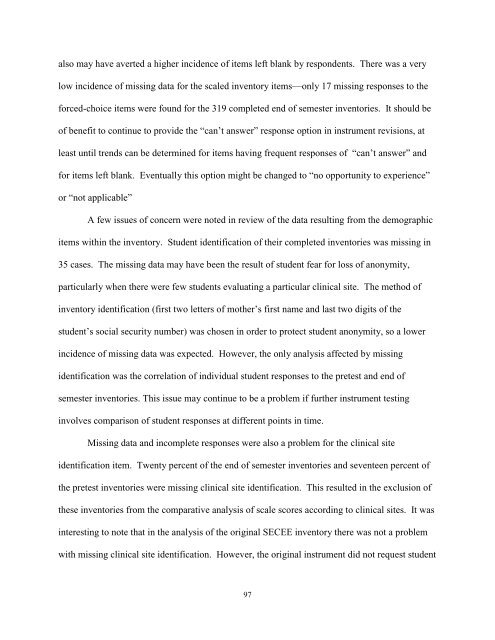STUDENT EVALUATION OF CLINICAL EDUCATION ENVIRONMENT
STUDENT EVALUATION OF CLINICAL EDUCATION ENVIRONMENT
STUDENT EVALUATION OF CLINICAL EDUCATION ENVIRONMENT
Create successful ePaper yourself
Turn your PDF publications into a flip-book with our unique Google optimized e-Paper software.
also may have averted a higher incidence of items left blank by respondents. There was a very<br />
low incidence of missing data for the scaled inventory items—only 17 missing responses to the<br />
forced-choice items were found for the 319 completed end of semester inventories. It should be<br />
of benefit to continue to provide the “can’t answer” response option in instrument revisions, at<br />
least until trends can be determined for items having frequent responses of “can’t answer” and<br />
for items left blank. Eventually this option might be changed to “no opportunity to experience”<br />
or “not applicable”<br />
A few issues of concern were noted in review of the data resulting from the demographic<br />
items within the inventory. Student identification of their completed inventories was missing in<br />
35 cases. The missing data may have been the result of student fear for loss of anonymity,<br />
particularly when there were few students evaluating a particular clinical site. The method of<br />
inventory identification (first two letters of mother’s first name and last two digits of the<br />
student’s social security number) was chosen in order to protect student anonymity, so a lower<br />
incidence of missing data was expected. However, the only analysis affected by missing<br />
identification was the correlation of individual student responses to the pretest and end of<br />
semester inventories. This issue may continue to be a problem if further instrument testing<br />
involves comparison of student responses at different points in time.<br />
Missing data and incomplete responses were also a problem for the clinical site<br />
identification item. Twenty percent of the end of semester inventories and seventeen percent of<br />
the pretest inventories were missing clinical site identification. This resulted in the exclusion of<br />
these inventories from the comparative analysis of scale scores according to clinical sites. It was<br />
interesting to note that in the analysis of the original SECEE inventory there was not a problem<br />
with missing clinical site identification. However, the original instrument did not request student<br />
97












